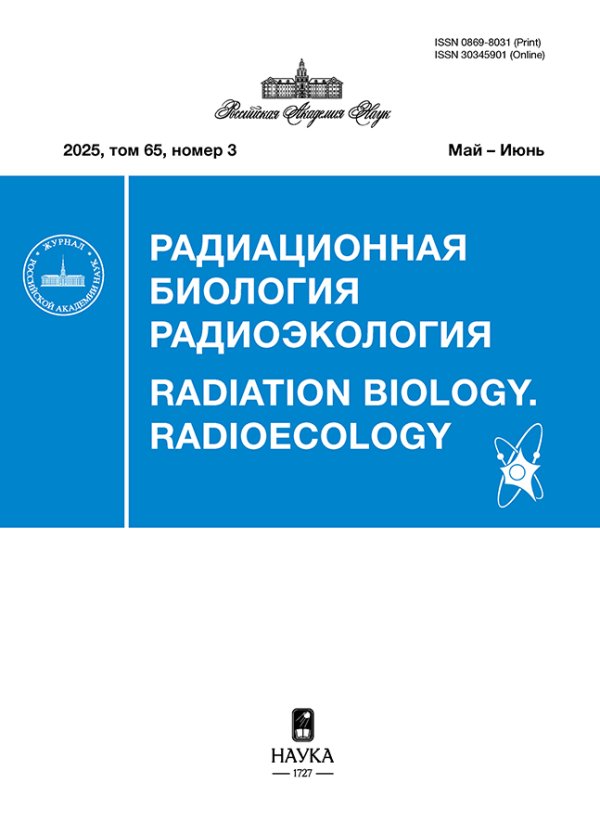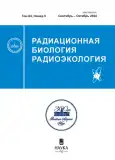Том 64, № 5 (2024)
Радиационная эпидемиология
Избыточный относительный риск смертности от болезней системы кровообращения после облучения. Сообщение 2. Объединяющий анализ данных для работников ядерной индустрии
Аннотация
Во второй части обзора по оценкам избыточных относительных рисков (ERR) на 1 Гр/Зв для смертности от болезней системы кровообращения («циркуляторные патологии»; ICD-9: 390–459; ICD-10: I00–I99) после облучения, проведены объединяющий анализ и мета-анализ для работников ядерной индустрии различных стран. Полнота выборки на конец 2021 г. являлась, по-видимому, исчерпывающей. Объединяющий анализ данных состоял в оценке средних тенденций для выборки после элиминации из нее выпадающих значений; ERR на 1 Гр/Зв составил 0.20 (95% CI: 0.11; 0.30). Мета-анализ проводился для полной выборки, без удаления выпадающих величин. Была выявлена определенная гетерогенность, поэтому для мета-анализа использовалась Random effect model, и ERR на 1 Гр/Зв составил 0.11 (95% CI: 0.01; 0.22). Полученная здесь только для работников ядерной индустрии средняя величина (а также результат мета-анализа) для ERR на 1 Гр/Зв мало отличались от данных мета-анализов M.P. Little с соавторами (2010–2016) для гетерогенных выборок из различных контингентов. В то же время данные для ПО «Маяк» по смертности от циркуляторных патологий в целом, а не для их отдельных типов, свидетельствуют о меньших рисках для внешнего воздействия (Azizova T.V. et al., 2018): ERR на 1 Гр/Зв составил 0.04 (95% CI: –0.00; 0.09). Все приведенные риски с позиции классической эпидемиологии, при использовании распространенной шкалы Монсона для относительных рисков (RR), должны считаться или отсутствующими (RR = 1.0–1.2), или слабыми (RR = 1.2–1.5). Оценка абсолютного риска смертности от циркуляторных патологий для гипотетической группы работников ядерной индустрии в 100 000 человек, каждый из которых накопил дозу 1 Гр, исходя из данных по фоновой смертности мужчин от названных патологий для США, продемонстрировала прибавку в 1400 смертей за 20 лет занятости. Однако пересчет на реальную среднюю дозу, накапливаемую работниками разных стран (31.1 мЗв; Котеров А.Н. и др., 2021; 2022), выявил ничтожную прибавку смертности — 0.6% от фонового уровня, и риск такого уровня не может быть учтен для столь многофакторных патологий. Полученные во второй части представленного исследования результаты: а) еще раз подкрепляют вывод, сделанный в Сообщении 1, о целесообразности придерживаться порога дозы в 0.5 Гр для смертности от циркуляторных патологий, установленного НКДАР ООН, МКРЗ, NCRP, BEIR и др.; б) свидетельствуют об очень низких, пренебрежимо малых рисках смертности от циркуляторных патологий, атрибутивных лучевому фактору, для работников ядерной индустрии последних десятилетий и для большей части таковых даже начального периода; в) показывают, что для реальной деятельности и охраны здоровья большинства работников ядерной индустрии определение/высчитывание лучевых рисков смертности от циркуляторных патологий носит исключительно теоретический характер. Данные выводы важны в том числе для экспертных советов по установлению причинности профессиональных патологий у работников ядерной индустрии.
 451–464
451–464


Радиационная генетика
Спектр вариантов последовательности гена TP53 у хронически облученных людей
Аннотация
Известно, что ионизирующее излучение способно повреждать генетический аппарат клетки не только за счет прямого воздействия, но и посредством индукции оксидативного стресса. Так, в результате окисления азотистого основания гуанина (G) продуктами оксидативного стресса могут возникать трансверсии типа G:C>T:A и G:C>С:G в гене-супрессоре опухолевого роста ТР53. В свою очередь, соматические и наследуемые варианты гена TP53 имеют большое значение в развитии злокачественных новообразований. В связи с этим, целью исследования явился анализ трансверсий G:C>T:A и G:C>С:G гена TP53 в клетках периферической крови, лиц, подвергшихся хроническому низкоинтенсивному радиационному воздействию. Представлены результаты анализа спектра вариантов последовательности гена TP53 на основе трансверсий G:C>T:A и G:C>С:G в клетках периферической крови у жителей прибрежных сел реки Течи Челябинской и Курганской областей, которые в 1950-х годах подверглись хроническому низкоинтенсивному радиационному воздействию. Диапазон индивидуальных значений накопленной поглощенной дозы облучения красного костного мозга за счет внешнего γ-излучения и ⁹⁰Sr составил от 2.1 до 2742.0 мГр (среднее значение – 605.4 ± 191.9 мГр (М ± SE)). В результате исследования у обследованных лиц в было выявлено семь различных вариантов гена TP53 на основе трансверсий G:C>T:A и G:C>С:G, представляющих собой однонуклеотидные замены. Все обнаруженные варианты присутствовали в базе данных IARC TP53 Database и не имели клинического значения как «патогенные» или «вероятно патогенные». Различия частот носителей обнаруженных вариантов гена TP53 между группой сравнения и основной группой не достигали статистически значимого уровня.
 465–472
465–472


Радиационная биофизика
Методология системного анализа физико-химических механизмов радиогенных повреждений организма животных и человека (опыт и тенденции)
Аннотация
Исследования в активно пролиферирующих тканях фермента рибонуклеотидредуктаза с помощью низкотемпературной ЭПР-спектроскопии и параллельный цитогенетический анализ тканей и крови свидетельствуют о начальных радиационно-индуцированных пусковых событиях, инициирующих генерацию повреждений ДНК в органах кроветворения. Изучение комплекса ЭПР-характеристик метаболических реакций с участием свободных радикалов и парамагнитных металлокомплексов выявило выраженный дозозависимый динамический SOS-ответ важнейших систем жизнеобеспечения организма в условиях общего γ-облучения. В механизме противолучевого эффекта радиопротекторов повышение активности рибонуклетидредуктазы и индуцирование синтеза дезоксирибонуклеотидов необходимо для эффективной репарации повреждений и синтеза ДНК в клетках радиочувствительных органов. Использование ЭПР-биомаркеров позволило обосновать дозы и режимы введения радиопротекторов для получения оптимальной радиозащиты.
 473–488
473–488


Модификация радиационных эффектов
Роль биоэнергетических эффектов цистамина в реализации потенцирования противолучевых свойств радиопротектора в режиме его повторного применения
Аннотация
Ранее был обнаружен феномен (Б.И. Давыдов, 1971, М.В. Васин, В.В. Антипов, 1972) по потенцированию противолучевых свойств аминотиолов (цистамина) при повторном применении в первые 7 ч последействия препарата с увеличением его активности в 2 раза. Предложена гипотеза по объяснению данного феномена. Механизм противолучевых свойств цистамина связан с частичной нейтрализацией кислородного эффекта с развитием в клетке восстановительного стресса, который не завершается после прекращения защитного действия радиопротектора. В организме на уровне клетки осуществляются механизмы с обратной отрицательной связью, препятствующие в полной мере осуществлению пагубных последствий восстановительного стресса, где ведущую роль занимает транскрипционный индуцируемой гипоксией фактор HIF-1, который усиливает в этих условиях продукцию АТФ за счет гликолиза и тем самым снижает нагрузку на процессы окислительного фосфорилирования в условиях острой гипоксии. При повторном применении цистамина в первые 7 ч его последействия после прекращения его противолучевой активности имеет место усиление проявления восстановительного стресса в виде метаболических сдвигов с развитием глубокой гипотермии у животных до 29°С ректальной температуры, что препятствует реализации действия HIF-1. Эти процессы способствуют более полной реализации пострадиационной репарации разрывов ДНК за счет предоставления для нее большего времени в условиях более длительной гипотермии и митотической блокады под действием цистамина.
 489–498
489–498


Общая радиобиология
Определение граничных уровней возникновения эффектов хронического облучения млекопитающих с разной продолжительностью жизни
Аннотация
Оценены и сопоставлены нижние граничные значения мощности дозы хронического облучения для млекопитающих с низкой и высокой естественной продолжительностью жизни, при превышении которых появляются негативные радиобиологические эффекты. Подготовлена выборка данных, содержащих информацию о наблюдавшихся радиобиологических эффектах хронического облучения млекопитающих в зависимости от мощности поглощенной дозы. Выборка включает 118 записей для млекопитающих с высокой продолжительностью жизни и 92 записи – с низкой. Анализ данных выполнен методом непараметрической статистики. Показано, что нижний порог детерминированных радиационных эффектов при хроническом облучении долгоживущих млекопитающих составляет 0.1 мГр/сут, с 95%-ным доверительным интервалом 0.04 – 0.3 мГр/сут. Для млекопитающих с коротким естественным жизненным циклом это пороговое значение на порядок величины выше – 1 мГр/сут, с 95%-ным доверительным интервалом 0.5–1.1 мГр/сут. Сделан вывод, что количественные критерии радиационной безопасности для долгоживущих и короткоживущих видов млекопитающих различаются, что необходимо учитывать при оценке экологического риска радиационного загрязнения окружающей среды.
 499–509
499–509


Радиационная цитогенетика
Биологическая дозиметрия при ингаляционном поступлении Pu-239
Аннотация
Ранее полученные зависимости «доза–эффект» и «содержание радионуклида–эффект» для трех типов хромосомных аберраций (дицентриков, стабильных аберраций и суммарного числа аберраций) позволили построить биодозиметрическую систему. Показано, что эта система позволяет получить оценки индивидуальных доз и содержания ²³⁹Pu в организме как при остром, так и при хроническом ингаляционном поступлении низкотранспортабельных соединений плутония у работников ПО «Маяк». Относительная погрешность индивидуальных поглощенных в легких доз облучения, которые были рассчитаны с помощью биодозиметрической системы (по стабильным ХА и суммарному количеству ХА), варьировала в пределах от 5.4 до 83.6% (в среднем 39.8%). С другой стороны, также при хроническом поступлении плутония, относительная погрешность индивидуального содержания ²³⁹Pu в организме варьировала в относительно небольших пределах: от 6.2 до 51.6% (в среднем 42.8%). При остром поступлении плутония относительная неопределенность дозовой оценки составила в среднем ~35%.
 510–518
510–518


Неионизирующие излучения
Исследование механизма повышения биологической активности бензилпенициллина натриевой соли после обработки импульсным магнитным полем высокой напряженности
Аннотация
Магнитное поле способно изменять биологическую активность лекарственных препаратов, что может использоваться в медицине. Литературных данных о повышении биологической активности готовых лекарств под воздействием импульсных магнитных полей непосредственно перед их введением не обнаружено. В статье приведены данные о повышении антибактериальной активности бензилпенициллина натриевой соли после ее обработки импульсным магнитным полем. Цель работы – исследовать причины повышения биологической активности бензилпенициллина, показать изменения, которые происходят в молекуле под воздействием импульсного магнитного поля. Воздействие магнитного поля осуществляли на порошкообразный антибиотик на магнитно-импульсной установке с напряженностью магнитного поля Н = (0.09÷0.82) × 106 А/м. Форма импульса – затухающая синусоида с частотной характеристикой f = 40 кГц и f = 51 кГц. В исследованиях использовали экспериментальные методы ЯМР- и ИК-Фурье спектроскопии. Установлен сдвиг в величине химических сдвигов (δН) и констант спин-спинового взаимодействия (2JНН) сигналов метиленовых протонов бензильного заместителя в результате воздействия магнитного поля. С помощью ИК-Фурье спектроскопии выявлены изменения в полосах поглощения связей N–H и С = О амидной группировки и карбонильной группы лактамного цикла. Полученные спектральные данные позволяют сделать вывод об изменении геометрии молекулы бензилпенициллина натриевой соли в амидном фрагменте под влиянием импульсного магнитного поля, что возможно и является причиной повышения антибактериальной активности антибиотика.
 519–528
519–528


Радионуклиды
Влияние режима увлажнения аллювиальных почв на перераспределение радиоактивных изотопов цезия и стронция по физико-химическим формам
Аннотация
Трансформация гидрологического режима пойменных земель из-за изменения климата и антропогенного вмешательства в процессы перераспределения воды в естественных ландшафтах способна оказать существенное влияние на биологическую доступность долгоживущих радиоактивных изотопов цезия и стронция. В камеральном эксперименте установлено, что изменение влажности аллювиальной почвы в пределах 40–100% от полной влагоемкости вызывает перераспределение ¹³⁷Cs и ⁹⁰Sr по формам нахождения. Насыщение почвы водой приводит к увеличению доли водорастворимой формы ¹³⁷Cs, но доля водорастворимой формы ⁹⁰Sr при этом падает. Содержание ионообменной формы ¹³⁷Cs не зависит от влажности почвы. Поведение ионообменной формы ⁹⁰Sr в ответ на изменение влажности почвы зависит от ее характеристик: в дерново-глеевой почве, развивающейся на песчаном аллювии, наблюдается существенное увеличение доли ⁹⁰Sr на фоне роста влажности почвы; в дерново-глееватой почве, развивающейся на супесчаном аллювии, подобное явление не наблюдается. Доля извлекаемой тетрафенилборатом натрия формы ¹³⁷Cs возрастает при насыщении аллювиальных почв водой. Аналогично ведет себя и подвижная форма ⁹⁰Sr, однако при содержании воды 100% от полной влагоемкости в дерново-глеевой почве наблюдается резкое уменьшение доли подвижной формы этого радионуклида. В целом, прослеживается тренд к повышению доли биодоступных форм ¹³⁷Cs и ⁹⁰Sr в аллювиальных почвах при повышении их влагообеспеченности, однако характер и величина этого явления зависят от характеристик почвы.
 529–539
529–539


Радиоэкология
Аварийное реагирование в АПК: радиоэкологические уроки Кыштымской аварии
Аннотация
Описаны факторы, определяющие последствия аварии на химкомбинате «Маяк» для сельского хозяйства, и особенности формирования радиационной обстановки на загрязненной территории. Показано, что для обеспечения готовности к оперативному реагированию необходимы эффективная структура управления для принятия решений, наличие аварийных планов, прогностического расчетного инструментария и соответствующих нормативов для оперативного аварийного реагирования. Выполнен анализ защитных мероприятий, проведенных в различные периоды после Кыштымской аварии. Сформулированы уроки Кыштымской аварии, касающиеся готовности к аварийному реагированию, внедрения организационных, агрохимических, защитных мероприятий в АПК, а также использования накопленного опыта в науке и практике.
 540–548
540–548


Оценка дозы облучения биоты и человека при выбросе йода-131 радиофармацевтическим производством
Аннотация
В ходе производственной деятельности радиофармацевтических предприятий осуществляется выброс техногенного ¹³¹I. На примере Научно-исследовательского физико-химического института им. Л.Я. Карпова показан метод оценки радиоэкологической обстановки вокруг предприятия в многолетней динамике путем определения содержания радионуклида в компонентах природной среды, а также дозовых нагрузок на биоту и человека. Выполнен модельный расчет среднегодовой объемной активности радионуклида, основанный на Гауссовой модели рассеяния и переноса примеси в атмосфере, позволяющий определить ее в любой точке местности. Определено, что дозовые нагрузки на биоту изменялись от 0.5 мкГр/сут (для пчелы) до 8.7 мкГр/сут (для дождевого червя) и были значительно ниже экологически безопасных уровней облучения (100000 и 10000 мкГр/сут соответственно). Дозовая нагрузка на взрослого человека составила от 0.5 до 1.3 мкЗв/год, что не превышает квоту предела дозы для института им. Л.Я. Карпова 300 мкЗв/год. Подчеркнута необходимость учета в оценке радиоэкологической обстановки как молекулярной, так и аэрозольной формы ¹³¹I с целью предотвращения занижения оценки дозовой нагрузки до двух раз. Полученные оценки радиоэкологической обстановки вокруг Научно-исследовательского физико-химического института им. Л.Я. Карпова в 2015-2021 гг. свидетельствуют об отсутствии негативного радиационно-экологического воздействия на человека и окружающую его среду. Алгоритм оценки может быть применен для других предприятий, производящих выбросы радиоактивного йода.
 549–557
549–557


Хроника
К 70-летию со дня рождения Игоря Борисовича Ушакова
 558–560
558–560













